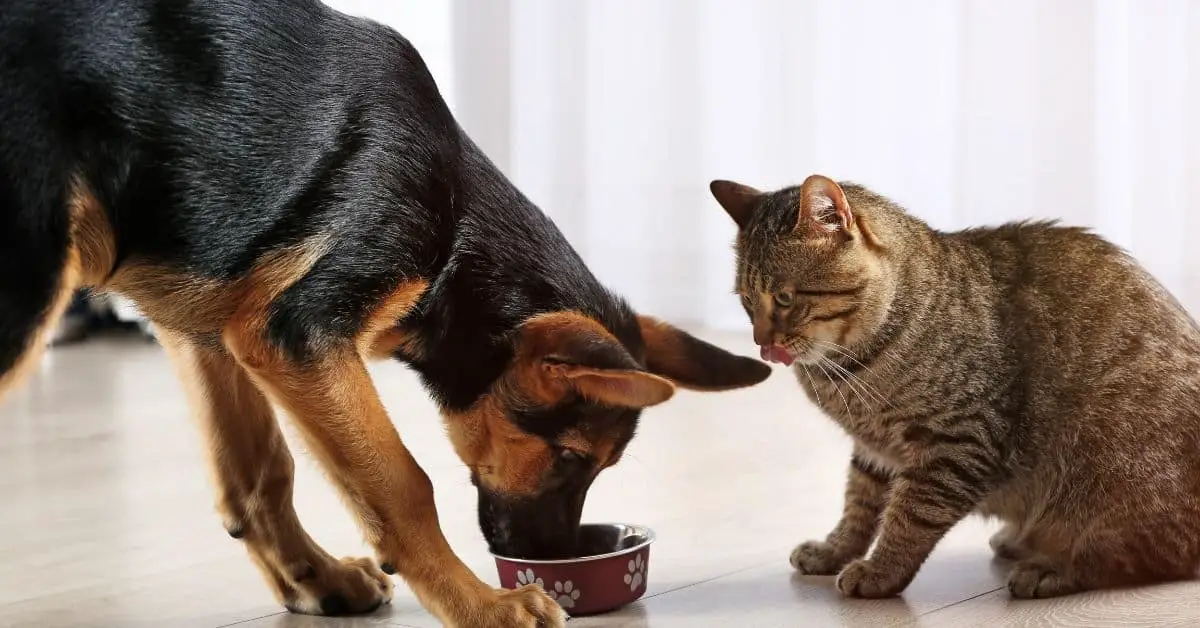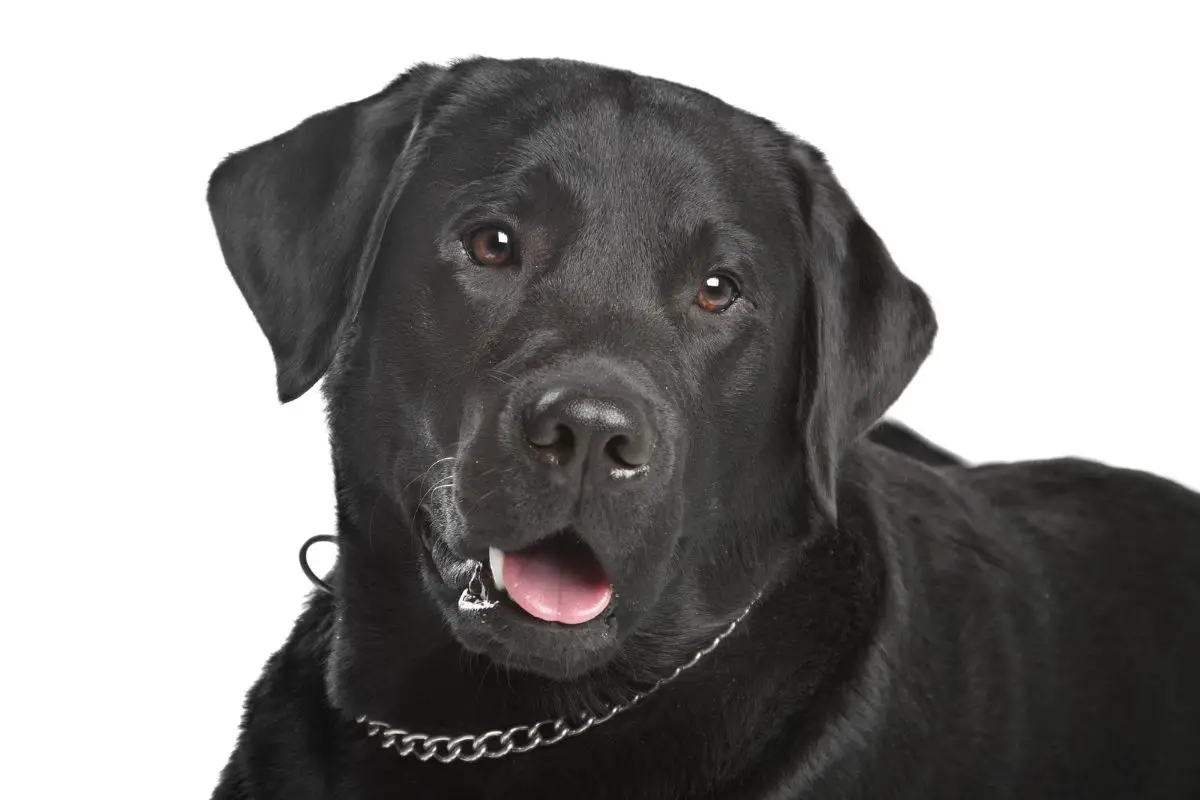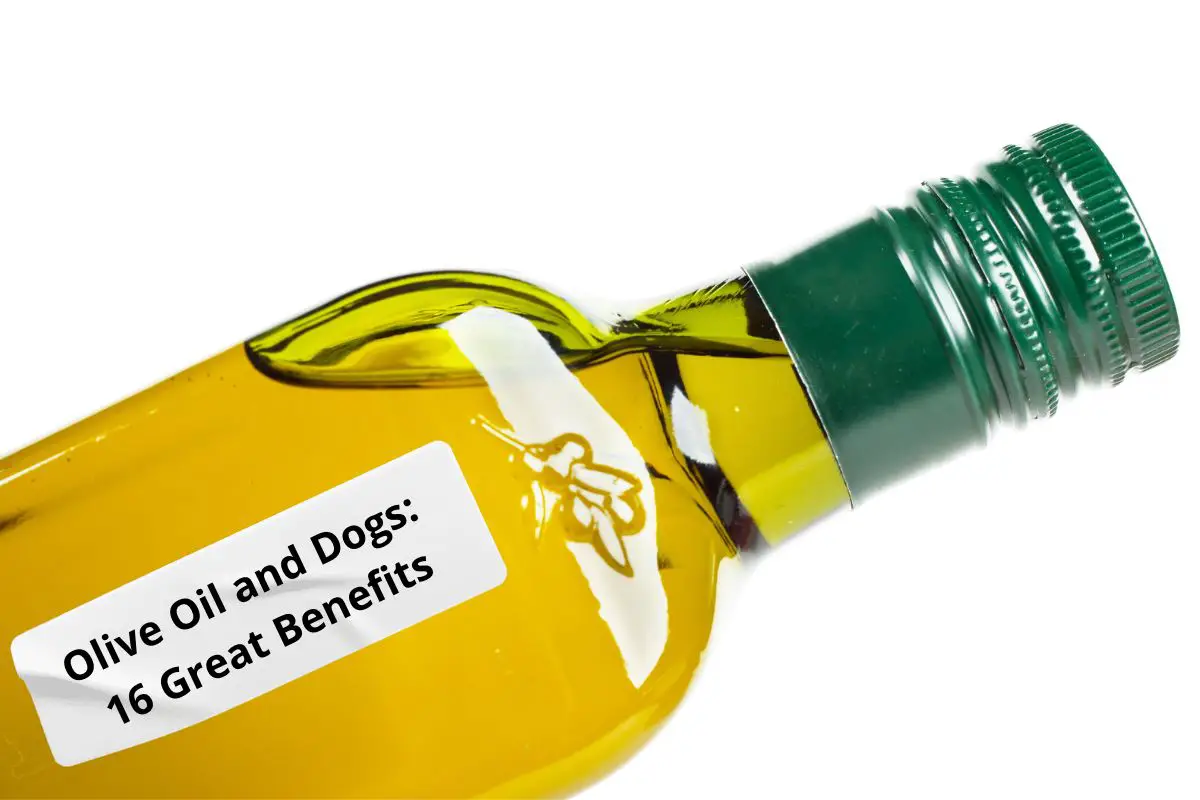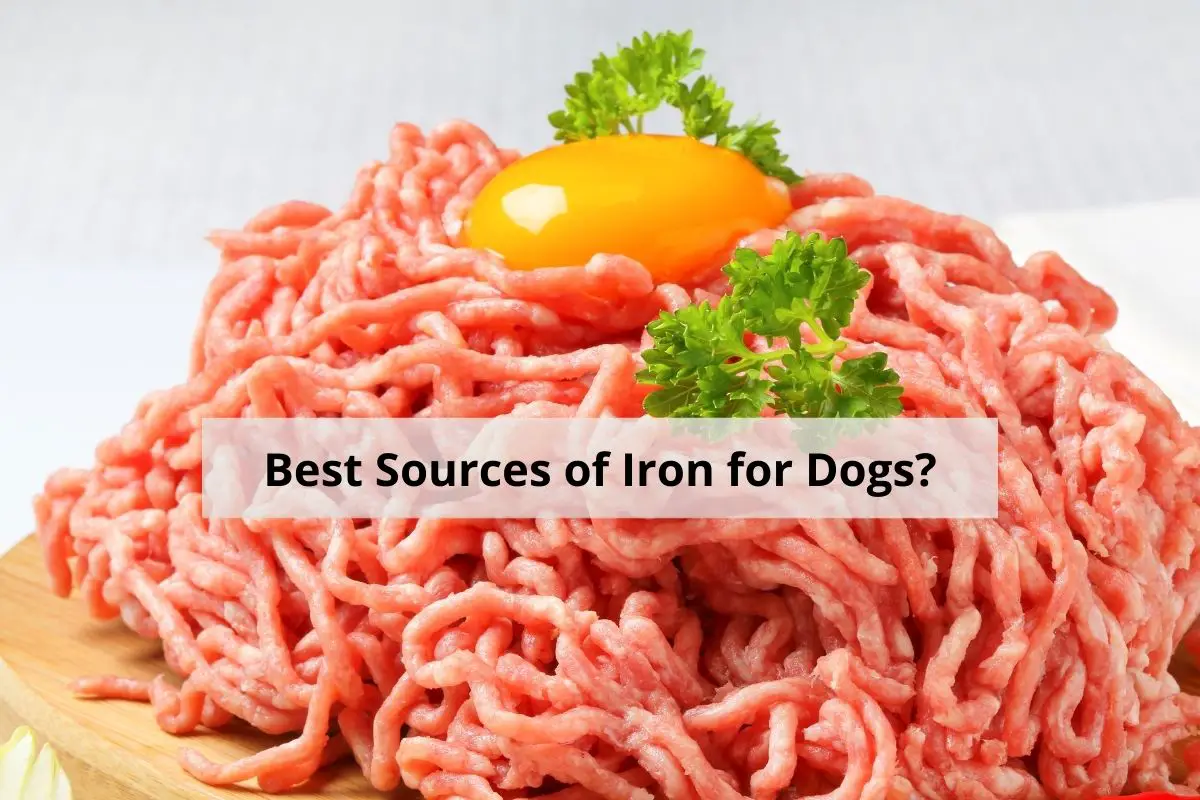This post contains affiliate links.
Cats and dogs are such popular staples of the American household that we sometimes forget how different they are. This is especially true for their food; it is perfectly normal to wonder if there are any real differences between cat food and dog food. Cats have certain nutritional needs that are different from a dog, so can a cat eat dog food, and is it safe?
Cats can’t eat dog food. Cats are carnivores by necessity and need adequate amounts of protein to function properly, and dog food tends to be lower in calories and higher in carbohydrates compared to cat food. Dog food also lacks certain amino acids that cats need to live.
With a house that has both varieties of pets, the expense of buying two kinds of pet food can add up, but it is crucial to buy premium cat food for your cat and not allow your feline to eat dog food. Even though small amounts of dog food will not outright kill a cat, it can be dangerous to consistently feed a cat dog food. Read on to find out more about the necessity of cat food and how dog food lacks key nutrients that cats need to survive.
Table of Contents
How Is Cat Food Different From Dog Food?
Cat food is such a common pet food that you may not ever stop to think about what makes it a different formulation from dog food. There is one common denominator when it comes to both cat food and dog food: meat. Cats and dogs love meat, especially raw meat, and there is an evolutionary reason behind this shared trait.
Both domestic dogs and cats descend from larger, wilder versions of canines and felines from the past. Protein was the main nutritional component of both the dog and cat family tree, and cats have never lost this evolutionary trait. Dogs have grown to be a bit more omnivorous over the centuries, but a cat’s diet is still mainly composed of strict protein.
Therefore, dog food contains a lot more concentrations of carbohydrates, vegetables, and other types of ingredients than what is seen in cat food. Dog food also has a thicker and more hearty consistency compared to cat food, and this is because dogs are usually larger and bulkier than cats. Both types of food have a strong aroma that will attract each animal to the other’s food.
Since cats are smaller than dogs, cat food is also high in calories to provide a cat with enough energy. Additionally, since dog food contains concentrations of vegetables and grains, this is not agreeable to a cat’s carnivorous system. This is why cat food is primarily composed of protein and fats with little to no carbohydrate or plant-based ingredients.
The primary contrast in cat and dog food boils down to each animal’s different dietary needs. There are specific amino acids, vitamins, and minerals that cats need to survive, and some of these ingredients do overlap in dog food as well. But there are some nutrients essential for a cat’s survival that are not found in dog food.
What Are the Dietary Needs of a Cat?
Cats need a regular diet of protein-rich amino acids, fats, vitamins, and minerals that respond to the evolutionary trait of eating a meat-based diet. Cats, unlike dogs and other animals, typically use protein for nearly all of their bodily functions. This includes bone and joint growth, brain function, and physical activity. Whereas dogs and even humans use carbohydrates as fuel, cats derive all their energy completely from protein.
Since dog and cat food can overlap a bit when it comes to ingredients, four main nutrient categories are crucial to overall cat health commonly found in cat food. Let’s explore each.
Taurine
Taurine is an amino acid from animal tissue that cats must obtain from their diet. Unlike dogs, cats cannot replicate this compound on their own, and if taurine is left out of a cat’s diet for long periods of time, this can cause a potentially fatal deficiency.
Taurine serves many beneficial purposes in cats, but the two main functions of taurine are promoting a healthy and strong heart in cats and a powerful immune system. These are major benefits for cats, and the concentrations of taurine in dog food are typically too low to give a cat the proper amounts that are needed.
Thankfully, this amino acid is found in nearly all cat food brands on the market due to research studies showing its necessity in the feline diet. If you are primarily feeding your cat a raw or cooked meat diet, it is always helpful to ensure that the meat of choice has high taurine amounts.
Arginine
Arginine is another chemical that belongs to the branch of amino acids. This unique amino acid is fairly common in dogs and even in humans, but just like taurine, cats cannot produce the amino acid naturally.
Thankfully, arginine is found in meat, which is the primary food product of the feline diet. Unfortunately, this amino acid is usually in small quantities in dog food since dogs do not need high amounts of this nutrient, making it dangerous.
Since cats digest and break down so much protein day after day, ammonia is released from the protein synthesis process. Arginine is responsible for removing ammonia from a cat’s body and preventing a cat from becoming sick due to ammonia build-up. If arginine is missing from a cat’s diet for a prolonged period of time, death is possible due to ammonia poisoning.
Like taurine, you can rest assured that arginine will be in most brands of cat food. It is recommended to check to ensure this important amino acid is found in your choice’s cat food. Wet cat food would be the best type of food to serve a cat to get the maximum arginine per serving.
Fats
Whereas humans do well with large amounts of omega-3 fatty acids in their diets and less omega-6 fatty acids, the reverse is true for cats. Omega-6 fatty acids come primarily from animal sources, and these fats provide much-needed energy and optimal organ health in cats.
An essential omega-6 fatty acid for cats is arachidonic acid. This type of fatty acid is essential for cats to produce necessary blood platelets and ensure proper reproductive functions. Since dogs can make this type of fatty acid independently, it is commonly left out of dog food, and a cat would be missing this key nutrient if they ate a dog food only diet.
Overall, fat of all varieties is beneficial for cats. Fats help to regulate cellular function and proper metabolic processes related to a cat’s energy stores. Because cats have to obtain certain kinds of fat from meat, this is usually why cat food is loaded with more fat than dog food. Whereas a cat eating dog food would cause nutritional deficiencies, a dog eating cat food would likely lead to weight gain due to high-fat concentrations.
Vitamins
Dog food is also filled with vitamins and minerals, so both cat food and dog food are more similar than different. Certain amounts of vitamins and minerals and different varieties are common between the two formulations; therefore, educating yourself on the vitamins and minerals essential for good cat health is helpful.
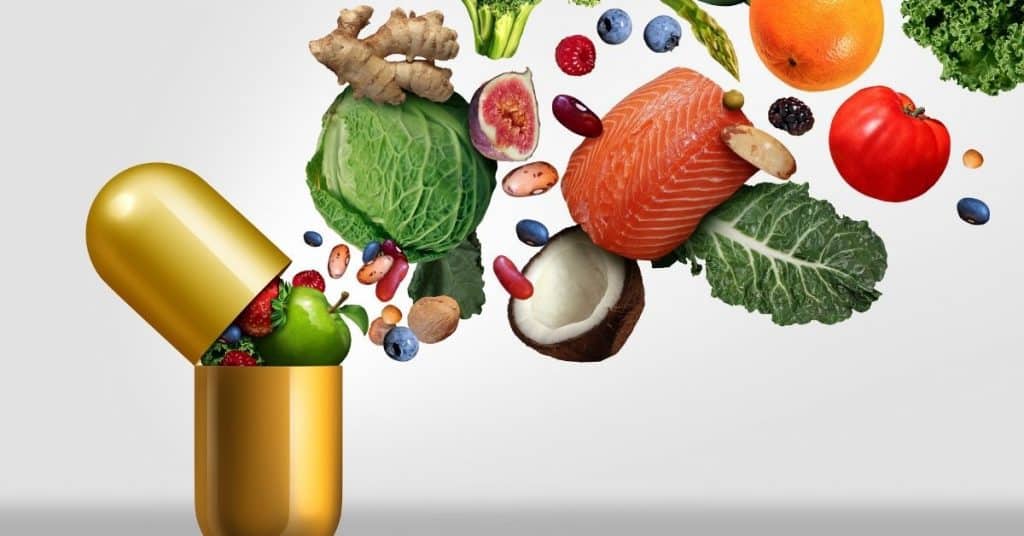
- Vitamin A. Vitamin A is important for all organisms, but when it comes to felines and meat is the only way to extract this essential vitamin. Vitamin A is beneficial for the proper nervous system, skin, and muscular function in cats. Dog food may not have enough vitamin A for cats since dogs can receive vitamin A much more easily than cats.
- Vitamin D3. Vitamin D and its protein-based version vitamin D3 are commonly found in both dog and cat food. Dogs and cats cannot naturally produce this vitamin through sunlight, so the dog and cat food manufacturers add the vitamin to food formulations. Unlike dogs, cats need the vitamin D3 type of vitamin D that is extracted from animal sources. This type of vitamin D may not be commonly found in dog food.
- Vitamin B. B vitamins are important for cats to ensure proper cellular health and skin and coat health. B vitamins are water-soluble vitamins, and if you have ever noticed the small amounts of water a cat drinks each day, this is because felines extract most of their moisture requirements from wet cat food. Therefore, it is important to make sure cat food is filled with b vitamins.
Is Dog Food Safe for Cats?
If your cat eats dog food, you do not have to worry about any fatal consequences. The problems with a cat eating dog food will only become noticeable if a cat eats nothing but dog food consistently. Lack of vital nutrients is what makes dog food dangerous to cats. Additionally, there are some ingredients in dog food that cats cannot digest properly.
Amusingly, you will likely find that cats do not like the smell or taste of dog food. Unlike dogs who are happy to gobble up virtually anything, a cat has a much more sensitive and picky brand of taste buds. If a food is not rich in protein and fat, felines will commonly turn away from the food. Add to this the thickness of dog food, and you have a situation that will not leave your cat feeling satisfied.
But if you think that your cat can eat dog food, rather he/she likes it or not, this is a dangerous assumption to make. As mentioned, cats have specific dietary needs that cannot be fulfilled by the omnivorous texture and nutritional value of dog food. On a prolonged dog food only diet, a cat could develop deadly taurine or arginine deficiencies. Cats will also be unable to digest the grains and vegetables in dog food properly.
So while the occasional bite of dog food will not harm a cat, a dog food diet could eventually lead to death in a cat since your feline cannot process certain ingredients in dog food.
How Long Can a Cat Eat Dog Food?
If you cannot acquire cat food for a day or two, your cat will receive some nutrients from dog food but will severely lack the essential nutrients needed from cat food. No cat should ever live on dog food for longer than 24-48 hours since this is when digestive processes will occur in a cat. Your cat will begin to process the harmful components in dog food, and strain will be put on the organs depleted of nutrients like taurine.
Due to the lack of arachidonic acid in dog food, a cat’s liver and kidneys will begin to show signs of distress. Dog food is also lower in calories than cat food, so your cat will become increasingly weaker due to the lack of energy from eating fewer calories than usual. If the dog food is dry, this can lead to severe dehydration for a cat since felines need wet food with high moisture concentrations.
A cat’s evolutionary biology prevents them from properly digesting grains; therefore, corn and wheat are found in dog food will cause abominable and digestive discomfort in a cat. This symptom can occur from just one serving of dog food. With this in mind, you would not want to feed a cat dog food for long periods of time if discomfort can occur from just one serving.
Both dogs and cats are naturally curious household pets, so there is no need to become worried if your feline sneaks a bite or two of dog food. This example should be the only time a cat is ever allowed to eat dog food, and do not consider switching your cat to dog food simply because they choose to eat it.
How Do I Deter My Cat From Eating Dog Food?
If you want to avoid this potentially dangerous problem, it helps separate your dog and cat feeding spots. It is never good to leave either dog or cat food out during the day and night. While you don’t have to worry about a dog eating cat food, cats can run into abdominal and digestive issues from as much as one bite of dog food.
Learn your cat’s eating habits and try to only put down a certain amount of cat food at one time. If your cat is hungry and dog food is within reach, a cat will likely eat the food in front of them. But you will generally have nothing to worry about if your cat has eaten recently. Consider feeding your cat in a room with a closed door and your dog in another room to avoid any double-dipping behaviors.
At the end of the day, wet dog foods are filled with meats that cats will naturally be attracted to. Ensuring that your dog’s food is completely out of view is the best method to take to prevent your cat from eating dog food. The potential health consequences for your cat are not worth it.
Are There Any Health Benefits for Cats Eating Dog Food?
Dog food is packed with protein and essential vitamins and minerals. But the problem comes from the lack of essential fatty acids and nutrients that cats need and dogs do not need. The reverse is also true of a dog’s eating of cat food; the high-fat content and calories could lead to weight gain with a dog.
Canned or wet dog food does contain high amounts of meat that a cat will certainly get benefits from, but there are also large amounts of plant protein. Cats need their protein intake to come directly from animal protein, leading to health problems for dogs who consume too much protein of this type. Plant proteins are added to dog food; cats cannot properly digest plant protein, and the nutritional benefit would be nonexistent.
The two types of pet food are specifically formulated to provide the essential nutrients of either a dog or cat; therefore, there are no real health benefits to be gained from either type of pet eating the opposite’s food. Your cat may receive benefits from eating wet dog food due to its moisture content, but this can be remedied by using wet cat food. A cat may receive vitamins and protein from dog food but miss out on key nutrients for essential cat health.
Final Thoughts
Can a cat eat dog food, and is it safe? Yes, a cat can eat dog food and, in some situations, will eat dog food if it is available, but this is not recommended. Dog food will not do your cat any favors in immediate health benefits and will only serve to cause potentially fatal health effects if served to a cat exclusively.
Cats need animal protein only, and the extra ingredients added to dog food will disrupt your cat’s system and cause problems. Be sure to separate your pets when feeding.
Related Articles
- Can Deer Eat Dog Food? What You Need To Know
- Can Rats Eat Dog Food? What You Need to Know
- Can Guinea Pigs Eat Dog Food? Avoid Affecting Your Pig’s Health!
- Can Rabbits Eat Dry Dog Food? My Opinion
- Can Sugar Gliders Eat Dog Food? Is It Safe?
- Can Fish Eat Dog Food? Is It Safe?
- Will Canned Dog Food Hurt My Cat? (We Ask the Experts)
Sources
- Feline Nutritional Foundation: Your Cat’s Nutritional Needs: The Basics
- The Canadian Veterinary Journal: One veterinarian’s experience with owners who are feeding raw meat to their pets
- Wikipedia: Omnivore
- The Canadian Veterinary Journal: Dry foods and risk of disease in cats
- Wikipedia: Taurine
- NASC: Taurine Deficiency in Cats
- Wikipedia: Arginine
- The Journal of Nutrition: Lysine and arginine requirements of the domestic cat
- Wikipedia: Omega-3 fatty acids
- Wikipedia: Omega-6 fatty acids
- American Journal of Veterinary Research: Essential fatty acid requirements of cats: Pathology of essential fatty acid deficiency
- Cornell University: Feeding Your Cat
- PetMD: Pet Food Bytes: The Difference Between Animal and Plant Protein
Mrdogfood.com is a participant in the Amazon Services LLC Associates Program, an affiliate advertising program designed to provide a means for sites to earn advertising fees by advertising and linking to Amazon.com. We also participate in other affiliate programs which compensate us for referring traffic.

